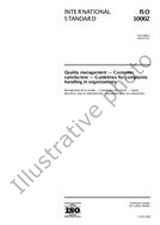We need your consent to use the individual data so that you can see information about your interests, among other things. Click "OK" to give your consent.

ISO 7870-3:2020-ed.2.0
Control charts — Part 3: Acceptance control charts
Translate name
STANDARD published on 29.5.2020
The information about the standard:
Designation standards: ISO 7870-3:2020-ed.2.0
Publication date standards: 29.5.2020
SKU: NS-994667
The number of pages: 21
Approximate weight : 63 g (0.14 lbs)
Country: International technical standard
Category: Technical standards ISO
The category - similar standards:
Annotation of standard text ISO 7870-3:2020-ed.2.0 :
Description / Abstract: This document gives guidance on the uses of acceptance control charts and establishes general procedures for determining sample sizes, action limits and decision criteria. An acceptance control chart should be used only when: a) the within subgroup variation is in-control and the variation is estimated efficiently; b) a high level of process capability has been achieved. An acceptance control chart is typically used when the process variable under study is normally distributed; however, it can be applied to a non-normal distribution. The examples provided in this document illustrate a variety of circumstances in which this technique has advantages; these examples provide details of the determination of the sample size, the action limits and the decision criteria.
We recommend:
Technical standards updating
Do you want to make sure you use only the valid technical standards?
We can offer you a solution which will provide you a monthly overview concerning the updating of standards which you use.
Would you like to know more? Look at this page.



 Cookies
Cookies
